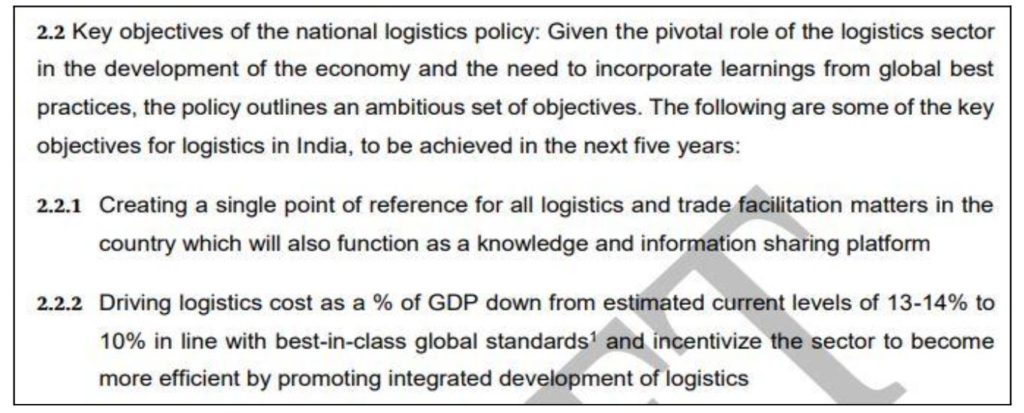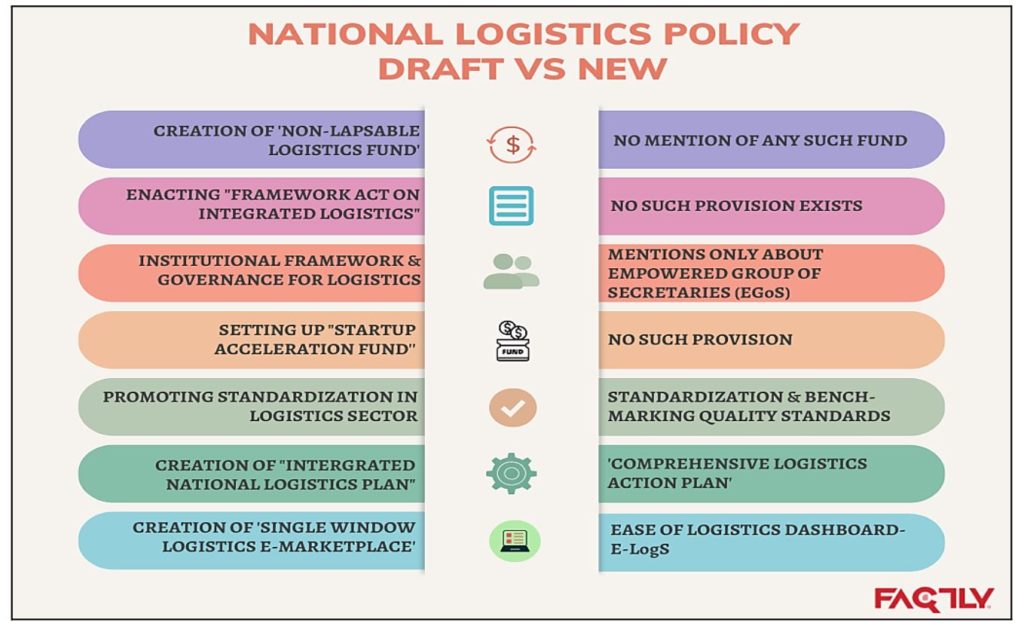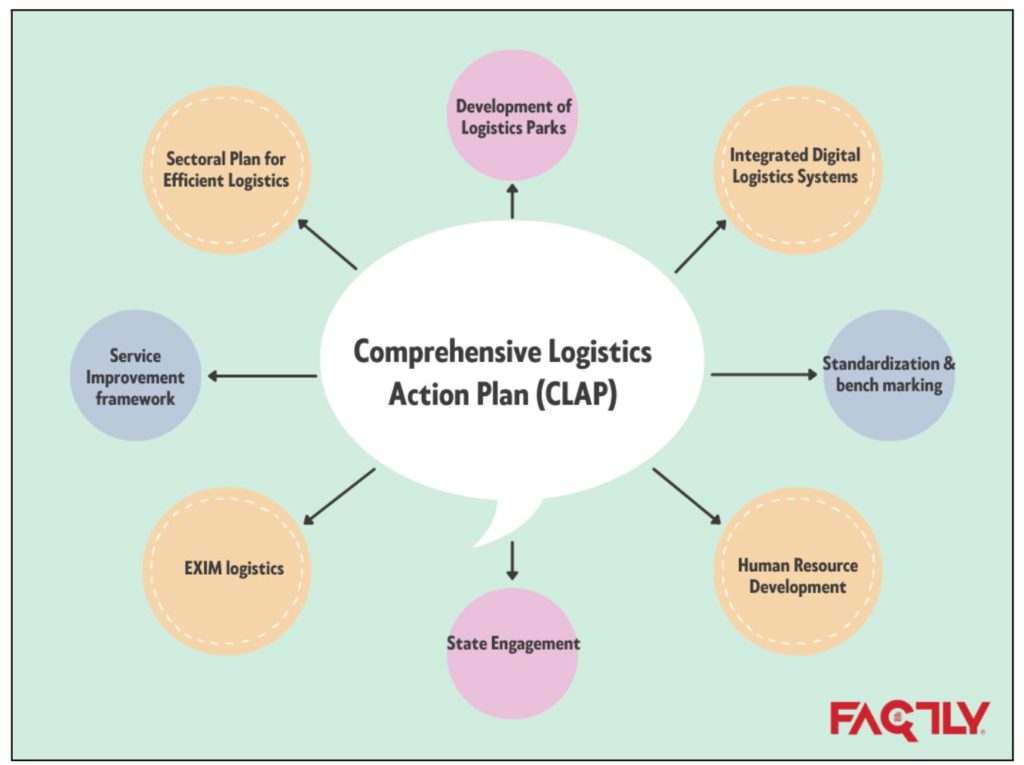Successive governments have made efforts in easing the bottlenecks of the logistics industry. These efforts were multi-sectoral, focusing on various aspects of the logistics industry. However, they weren’t as successful as were expected to be, leading to the underperformance of the industry. To make the industry more efficient and resilient, the Government of India has come up with the ‘National Logistics Policy 2022’.
The term ‘Logistics’ has various connotations. But, in simple language, logistics is all about RRR- Delivering the ‘Right Product’ to the ‘Right Place’ at the ‘Right Time’. Like the nerves that connect different organs performing crucial and specific functions in the human body, Logistics as an industry replicates the same functionality. Humans cripple when their nervous system fails, so does the nation when the logistics industry underperforms.
Successive governments have made efforts in easing the bottlenecks of the logistics industry. These efforts were multi-sectoral, focusing on various aspects of the logistics industry. However, they weren’t as successful as were expected to be, leading to the underperformance of the industry. In order to make the industry more efficient and resilient, the Government of India has come up with the ‘National Logistics Policy 2022’. Today’s story looks at the policy and what it entails.
Logistics at a glance
With more than 14% contribution to GDP, the Indian logistics industry is estimated to be valued at USD 200 billion. The Indian logistics industry is highly fragmented with more than 20 specialised entities and 37 export promotion organisations. Very often, this caused serious lapses in ensuring co-operation & coordination between them. Additionally, logistics is a highly labour-intensive industry. This industry provides employment to more than 12 million people and is expected to grow at the rate of 10.5% over the next 5 years. More than 80% of employment in this industry is also unorganized. With advancements in technologies, this industry is gradually shifting to embracing and adopting newer technologies. All these place the Indian logistics sector at a crucial juncture to remodel itself to suit the needs of the globalized world.
The National Logistics Policy 2022, hereby referred to as NLP 2022, focuses on these two key areas:
- Effective integration between different agencies in the logistics ecosystem
- Deploying and embracing newer technologies to smoothen the process flow
By focussing on these two themes, the Government expects positive changes in the performance of the logistics industry. Accordingly, it had set the below targets for itself.

Changes from the Draft National Logistics Policy
The Government released the Draft National Logistics Policy in 2018, seeking responses from the stakeholders as well as the public. The draft envisions creating seamless, reliable, and cost-effective logistics network, leveraging the skilled workforce and the evolving technologies. It had two key objectives.

The draft contained four critical aspects, which do not find a mention in the new policy.
- It suggested the enactment of the ‘Framework Act on Integrated Logistics’ whose primary objective was to determine the roles and responsibilities of all the stakeholders in the multi-modal logistics space and institutionalize them.
- It further suggested the creation of an Institutional Framework & Governance for Logistics to ensure effective coordination across the various stakeholders and track progress. It envisions the setting up of four councils/committees.
- National Council for Logistics, chaired by the Prime Minister
- Apex inter-ministerial Committee, chaired by the Minister of Commerce & Industry
- India Logistics Forum chaired by the Commerce Secretary with representation from key industry/business stakeholders and academia.
- An empowered task force on logistics will be created, as a standing committee chaired by the head of the Logistics Wing.
- Additionally, it suggested the creation of a ‘Non-Lapsable Logistics Fund’ to drive progress against the key thrust areas of the policy.
- And to promote innovations and technologies, it recommended setting up a ‘Start-up Acceleration Fund’, whose goal is to help incubate start-ups in the logistics sector.
Key changes are summed up below:

What’s in the National Logistics Policy
The new National Logistics Policy has three major components:
- Comprehensive Logistics Action Plan (CLAP)
- Unified Logistics Interface Platform (ULIP)
- Dashboard for Ease of Logistics Services (E-LogS)
Among these three, CLAP acts as a foundation and all measures are implemented through it. It has eight core action areas as given below:

Unified Logistics Interface Platform (ULIP) is a promising effort that was developed to give an integrated platform that can be used by the stakeholders to improve efficiency, use technology, and lower the cost of logistics in India. Various government and business entities, service providers, shippers, consignees, etc. shall use this platform to facilitate confidential real-time information exchange among all parties. It was also named as one of the seven projects included in the “Technology Commons” initiative, which uses technology in several critical areas by creating top-notch goods and services that take important user and stakeholder needs into account.
Three levels make up the ULIP platform as a whole: the Integration layer, the Governance layer, and the Presentation layer. 30 logistics systems from 07 Ministries/Departments encompassing more than 1600 fields have been connected with ULIP through 102 APIs under the Integration layer and the Governance layer. The goal is to develop a UPI-like framework that will allow the logistic department’s transactions to be authenticated.
The industry department is creating a digital dashboard called Ease of Logistics (E-LogS) for recording, organising, and keeping track of time-bound issue resolution. Timelines and the progress of the resolution will be included. According to government representatives, strong oversight would guarantee that problems are not delayed. It attempts to create a logistical ecosystem that is supported by technology. There is also the formation of a Services Improvement Group (SIG) which comprises nominated officers from ministries for monitoring and coordination mechanisms for any unresolved issues.
NLP as a Pivot
While the initiatives toward developing the logistics sector had been segregated to date, the NLP aims to integrate all such efforts. Earlier initiatives such as FASTag, paperless EXIM trade process through e-sanchit, provisions for e-way bills, faceless assessment for customs etc., were aimed toward easing the logistics sector. On the infrastructural note, Bharatmala for road, Sagarmala for shipping, UDAN for aviation and PM Gati Shakti National Master Plan for multi-modal connectivity, aims to build the foundation for improving the turnaround times and efficiency of the logistics industry. NLP acts as a pivot to smoothen the movement of goods and services, ease regulatory compliances, and enable technology adoption for cost-effective and seamless coordination among different entities.
Through the implementation of NLP, the government aspires to be a frontrunner in the Logistics Performance Index (LPI) by the World Bank. The Logistics Ease Across Different States (LEADS) survey by the Ministry of Commerce and Industry also encourages states and UTs to engage in cooperative competitive federalism by learning about successful initiatives from other states. So far, 13 states have their own state logistics policy.
High on ambition, yet concerns remain
The National Logistics Policy is highly aspirational. Its vision and objectives, if implemented successfully, could bring in a sweeping transformation in the landscape of the logistics industry. Yet, there are a few crucial concerns that require adequate attention.
The first concern is regarding the execution. All these goals will not serve the purpose if implementational challenges are not overcome. These challenges could be in terms of on-time completion of infrastructural projects, enabling a secured database of data when the entire process chain is made digital, absence of adequate complementing services such as storage facilities, warehouses, and so on.
The second concern is regarding the Sustainability and Greening of the Logistics industry. The Indian logistics industry is heavily dependent on roads, and the transportation sector is one of the leading contributors to global carbon emissions. NITI Aayog’s report ‘Transforming Trucking in India’ projects that the adoption of zero-emission trucks can avoid 838 billion litres of diesel consumption cumulatively by 2050, resulting in upward of $1.5 trillion of reduced oil expenditures. It, therefore, becomes inevitable to undertake reforms that promote green or eco-friendly logistics. It is necessary to examine the existing supply chain networks and undertake sustainable actions such as consolidation of freight, balancing different modes of transportation, warehouse space optimisation, and data-enabled decision-making.
The final concern is the working model of the logistics industry. There are no uniform acceptable standards of pricing in the industry, with different operators charging different prices. There is a need to explore benchmark pricing policies while giving enough flexibility. Further, the fleet of most logistics transportation is old and caters only to certain specific types of goods. It is adopting newer fleet models that are greener, cost-efficient and can carry any type of goods. Government subsidies & incentives to adopt such a fleet can go a long way.
Featured Image: National Logistics Policy 2022


